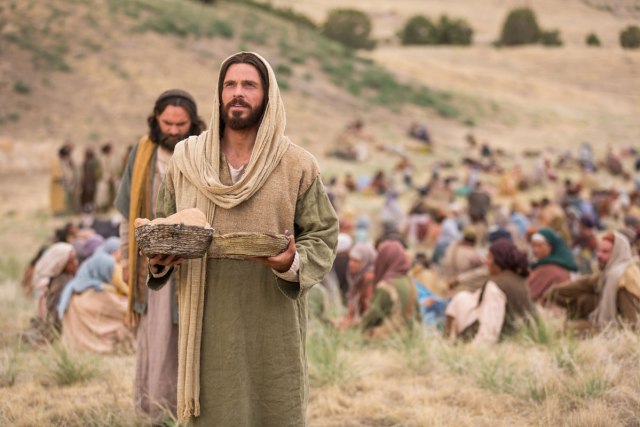Recently I was asked about the feedings of the multitudes in the text of the Gospels. What do the two feedings mean? Is there some symbolism here?
 I have read some commentaries from writers that get into the numbers and their symbolism regarding the two accounts of the multiple feedings of the multitude.
I have read some commentaries from writers that get into the numbers and their symbolism regarding the two accounts of the multiple feedings of the multitude.
In all four gospel accounts (John 6, Matthew 14, Luke 9, and Mark 6) Jesus feeds 5,000 with 12 baskets full of food left over.
The second miracle, the “Feeding of the 4,000,” with seven loaves of bread and fish, is reported by Matthew 15:32-39 and Mark 8:1-9, but not by Luke or John. In the second feeding there are 7 baskets left over.
Shortly after this, we read the following exchange between Jesus and his apostles:
18 Having eyes, see ye not? and having ears, hear ye not? and do ye not remember?
19 When I brake the five loaves among five thousand, how many baskets full of fragments took ye up? They say unto him, Twelve.
20 And when the seven among four thousand, how many baskets full of fragments took ye up? And they said, Seven.
21 And he said unto them, How is it that ye do not understand? (Mark 8.18-21)
What does this mean?
I have read many commentaries on this and they give all kinds of interpretations. In my opinion, the numbers do matter.
So here is one way to look at the text:
The number 12 does and can represent the 12 tribes of Israel in this context. Jesus is taking himself, “the bread of life” to the House of Israel.
The number 5 can and does represent grace/mercy in this context. So 5,000 is an extension of this idea.
In the second feeding, Jesus feeds 4,000, which is basically an extension of the number 4. The number 4 can represent the total mortal experience. 4 can and does represent mortality in this context. So Jesus takes himself, “the bread of life” to the rest of the world after Israel has the chance to partake. The 7 baskets can represent the totality of his work. It is “7” or complete. It is sheba, a word that can mean to make a promise or an oath, or to be complete- an idea relating to this number in classical Hebrew.1 In the mind of the author of the account of the feeding of the 4,000 it is reasonable to see this as symbolic of Jesus as the God who has completed his work.
This is one way to look at the text. This is not the only way that the text can be read. But to whoever penned the account in Mark 8, these numbers mattered. I am of the belief that this author understood how these numbers had deep meaning to the Jews who lived in this time period. While much of the symbolism can be lost to modern readers, I do find evidence that it was not lost on our fellow ancient believers that valued these texts. The fact that all four gospel writers took the time to give an account of the first feeding account should tell us something.
Notes
- Strongs Hebrew #7646 שבע saba` {saw-bah’} or שבע sabea` {saw-bay’-ah} a primitive root; TWOT – 2231; v AV – satisfy 47, fill 25, full 15, plenty 2, enough 2, satiate 1, sufficed 1, unsatiable 1, weary 1; 95 1) to be satisfied, be sated, be fulfilled, be surfeited 1a) (Qal) 1a1) to be sated (with food) 1a2) to be sated, be satisfied with, be fulfilled, be filled, have one’s fill of (have desire satisfied) 1a3) to have in excess, be surfeited, be surfeited with 1a3a) to be weary of (fig) 1b) (Piel) to satisfy 1c) (Hiphil) 1c1) to satisfy 1c2) to enrich 1c3) to sate, glut (with the undesired). Strongs Hebrew #7650 שבע shaba` {shaw-bah’} a primitive root; TWOT – 2318; v AV – sware 167, charge 8, oath 7, adjure 3, straitly 2; 187 1) to swear, adjure 1a) (Qal) sworn (participle) 1b) (Niphal) 1b1) to swear, take an oath 1b2) to swear (of Jehovah by Himself) 1b3) to curse 1c) (Hiphil) 1c1) to cause to take an oath 1c2) to adjure. Strongs Hebrew #7651 שבע sheba` {sheh’-bah} or (masc.) שבעה shib`ah {shib-aw’} from 07650; TWOT – 2318; n m/f AV – seven 355, seventh 13, seventeen + 06240 8, seven times 6, seventeenth + 06240 6, seventeenth 5, sevens + 07657 2, seven men 1, sevenfold 1, seventeen + 06235 1, seventeen + 07657 1; 394 1) seven (cardinal number) 1a) as ordinal number 1b) in combination – 17, 700 etc.
